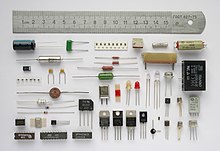This is an old revision of this page, as edited by 金色黎明 (talk | contribs) at 03:31, 24 January 2025 (←Created page with ''''Epoxy Molding Compounds''' ('''EMC''') represent a category of advanced materials utilized in electronic packaging, primarily consisting of epoxy resin, phenolic compounds, curing agent, fillers, and various additives.<ref>{{Cite book |title=Advances in Embedded and Fan‐Out Wafer‐Level Packaging Technologies |date=2019 |publisher=John Wiley & Sons, Inc |location=Hoboken, NJ, USA |isbn=...'). The present address (URL) is a permanent link to this revision, which may differ significantly from the current revision.
Revision as of 03:31, 24 January 2025 by 金色黎明 (talk | contribs) (←Created page with ''''Epoxy Molding Compounds''' ('''EMC''') represent a category of advanced materials utilized in electronic packaging, primarily consisting of epoxy resin, phenolic compounds, curing agent, fillers, and various additives.<ref>{{Cite book |title=Advances in Embedded and Fan‐Out Wafer‐Level Packaging Technologies |date=2019 |publisher=John Wiley & Sons, Inc |location=Hoboken, NJ, USA |isbn=...')(diff) ← Previous revision | Latest revision (diff) | Newer revision → (diff)Epoxy Molding Compounds (EMC) represent a category of advanced materials utilized in electronic packaging, primarily consisting of epoxy resin, phenolic compounds, curing agent, fillers, and various additives. To safeguard electronic components against mechanical damage, contamination, and moisture, mass production techniques such as injection molding or transfer molding are typically employed to encapsulate these components within the EMC. Upon curing, the epoxy resin develops a three-dimensional network structure that exhibits superior mechanical properties as well as resistance to heat and moisture, rendering it highly effective in protecting devices from environmental factors.
History

The development of semiconductor technology commenced in the 1940s with the introduction of germanium diodes, subsequently progressing with the invention of transistors. This innovation facilitated the miniaturization of circuits and reduced power consumption, thereby catalyzing the emergence of the contemporary computer era. The packaging employed for these semiconductor devices serves to provide protection and enables their connection to printed circuit boards. Initially, the packaging technology utilized for diodes and transistors involved canned sealing. However, with advancements in passivation technology, plastic packaging methods were introduced. This plastic packaging technology has proven instrumental in enabling the mass production and cost-effective supply of semiconductor devices.
The advancement of plastic packaging technology has facilitated its extensive utilization in both consumer and industrial products. Currently, over 80% of semiconductor devices are encapsulated using epoxy molding compounds.
The advancement of semiconductor technology has consistently encountered the challenge of enhancing functionality while simultaneously reducing physical dimensions. The integration of an increasing number of functions onto semiconductor chips has resulted in a corresponding rise in both the number of pins and the overall size of the chips. Conversely, to facilitate more compact arrangements on circuit boards, there has been a trend towards miniaturization and reduction in the thickness of packaging.
Reference
- Keser, Beth; Kroehnert, Steffen, eds. (2019). "The Role of Liquid Molding Compounds in the Success of Fan‐Out Wafer‐Level Packaging Technology". Advances in Embedded and Fan‐Out Wafer‐Level Packaging Technologies. Hoboken, NJ, USA: John Wiley & Sons, Inc. ISBN 978-1-119-31399-1.
- Zhao, Yang; Drummer, Dietmar (2019-11-01). "Influence of Filler Content and Filler Size on the Curing Kinetics of an Epoxy Resin". Polymers. 11 (11). doi:10.3390/polym11111797. ISSN 2073-4360. PMC 6918384. PMID 31683998.
{{cite journal}}: CS1 maint: unflagged free DOI (link) - ^ Benoit, Henri; Fujita, Hiroshi; Cantow, Hans-Joachim; Dus̆ek, Karel; Henrici-Olivé, Gisela; Heublein, Günter; Höcker, Hartwig; Kausch, Hans-Henning; Kennedy, Joseph Patrick II (1989). "Epoxy Molding Compounds as Encapsulation Materials for Microelectronic Devices". Speciality Polymers/Polymer Physics. Advances in Polymer Science. Berlin, Heidelberg: Springer-Verlag Springer e-books. ISBN 978-3-540-46010-7.